

Auckland Libraries - OverDrive. How to Assist a Student with Dysgraphia. Understanding Dysgraphia in Children. What is dysgraphia?

Dysgraphia is a condition that causes trouble with written expression. The term comes from the Greek words dys (“impaired”) and graphia (“making letter forms by hand”). Dysgraphia is a brain-based issue. It’s not the result of a child being lazy. For many children with dysgraphia, just holding a pencil and organizing letters on a line is difficult. Different professionals may use different terms to describe your child’s struggle with written expression. Some school psychologists and teachers use the term dysgraphia as a type of shorthand to mean “a disorder in written expression.” Whatever definition is used, it’s important to understand that slow or sloppy writing isn’t necessarily a sign that your child isn’t trying hard enough.
Back to the top. Dysgraphia Slideshare Presentation. Dysgraphia Treatment for Children & Adults, at School or Home. Dysgraphia: Exploring Effective Strategies. Dysgraphia: Exploring Effective Strategies Dysgraphia is a learning disability that affects handwriting and fine motor skills.
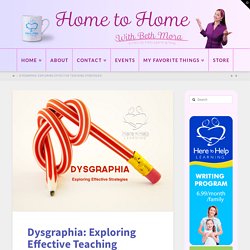
Forming letters is labored and difficult for these students. Parents and teachers often wonder, how can I help? Here is my immediate disclosure: I am not a doctor or learning disability specialist. My background is a Certified Rehabilitation Registered Nurse Specialist or C.R.R.N. Strengthen Fine Motor Skills Fine motor skills are required to write legibly. Dysgraphia: Strengthen Fine Motor Muscles Strengthen Core Muscles Homeschool speaker and author, Carol Barnier, tells a funny tale of her “sizzler” falling out of his chair and how common this bizarre calamity is among children who have learning challenges.
Fine Motor Activities for Students with Dysgraphia. Activities to Improve Fine Motor Coordination Activities like those listed below will help the child develop better control of fine movements in the hand. - Playing with small fridge magnets.
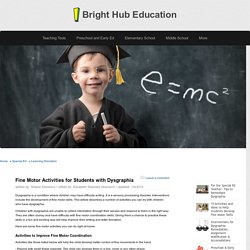
The child can arrange them in a line, circle or any other shape. - Making shapes with matchsticks - Making a tower with coins - On a piece of paper, draw small circles. . - Pouring liquids into small containers - Pick up sticks game ( You can do it with spaghetti) . - Picking up small pieces of colored paper and gluing them for a craft activity. - Gluing pulses, or sequins on to the outline of a simple shape or picture. - Sorting small colored Lego pieces according to their colors. - Pasting stickers or shapes on a paper where the outline is already drawn. Strategies for Dealing with Dysgraphia. By: Regina G.
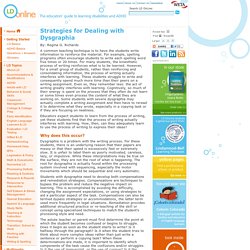
Richards A common teaching technique is to have the students write information to reinforce the material. For example, spelling programs often encourage students to write each spelling word five times or 20 times. For many students, the kinesthetic process of writing reinforces what is to be learned. However, for a small group of students, rather than reinforcing and consolidating information, the process of writing actually interferes with learning.
Educators expect students to learn from the process of writing, yet these students find that the process of writing actually interferes with learning. Why does this occur? Dysgraphia Awareness - Learning Disability 2015. Understanding Dysgraphia – International Dyslexia Association. Share This: For a downloadable PDF, click here.For a downloadable PDF in Spanish, click here.
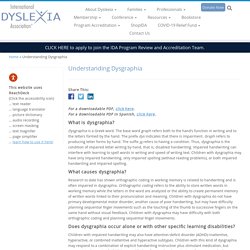
What is dysgraphia? Dysgraphia is a Greek word. The base word graph refers both to the hand’s function in writing and to the letters formed by the hand. Dysgraphia pic1. Creating a Dysgraphia-Friendly Classroom. Dysgraphia is a language-based learning difference that affects a student’s ability to produce written language. In the early grades, students with dysgraphia may have difficulty with consistent letter formation, word spacing, punctuation, and capitalization.
In later grades, they may have difficulty with writing fluency, floating margins, and legible writing. In the classroom, students with dysgraphia are often labeled “sloppy,” “lazy,” or “not detail-oriented.” But students with dysgraphia are often trying very hard, if not harder than others, just to keep up. Dysgraphia is an invisible disability that often goes hand in hand with dyslexia. To simulate the experience of having dysgraphia, try this: Write a paragraph about the best trip you’ve ever taken. How did that feel? Dysgraphia can be remediated with occupational therapy to strengthen fine motor skills, support written expression, and speed up language processing. Dysgraphia & Writing Difficulties. Teaching Students with Dyslexia and Dysgraphia: Lessons from Teaching and Science. Teaching Students with Dyslexia and Dysgraphia: Lessons from Teaching and Science Authors Virginia Berninger Ph.D., Beverly Wolf M.Ed.
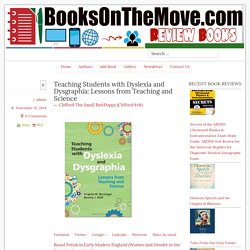
Availablity Usually ships in 24 hours Publisher : Brookes Publishing How can teachers provide effective literacy instruction for students with learning differences—while meeting the needs of all students in the class? Finally, a single accessible textbook answers that question for every KGÇô12 educator. Ginger Berninger, a seasoned researcher and former teacher, partners with 40-year teacher and teacher trainer veteran Beverly Wolf for a one-of-a-kind text that gives readers the best of both worlds: critical insights from scientific studies and lessons learned from actual teaching experience.
Throughout the book, relevant research findings from diverse fields—including genetics, neuroscience, cognitive science, linguistics, and education—show teachers the why behind the how.